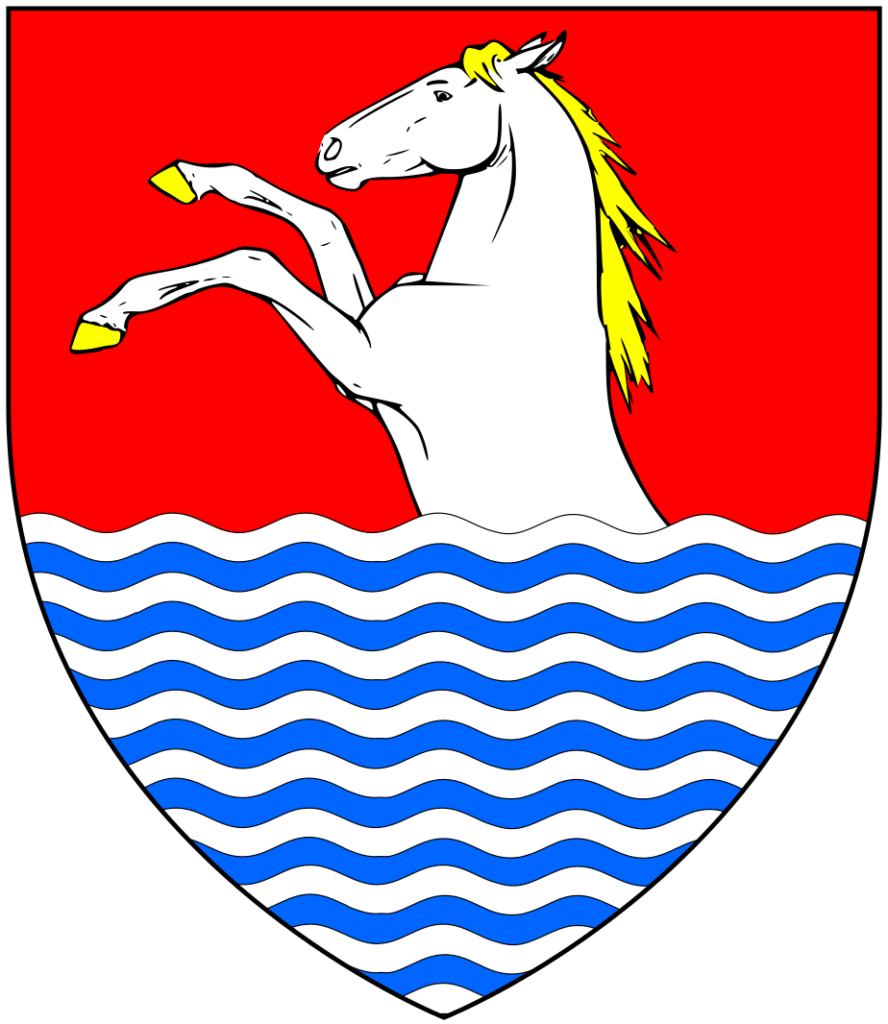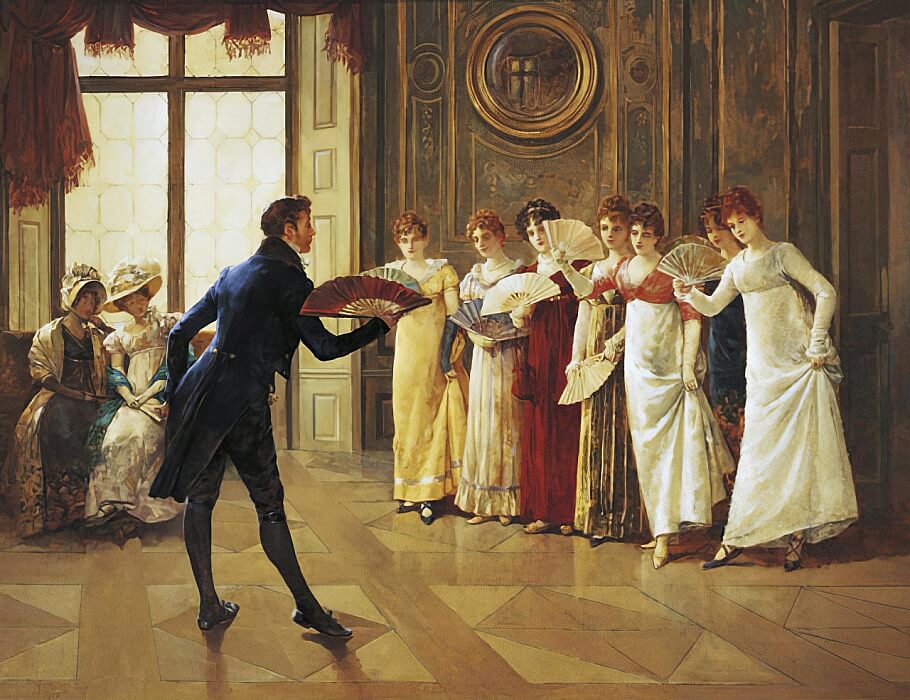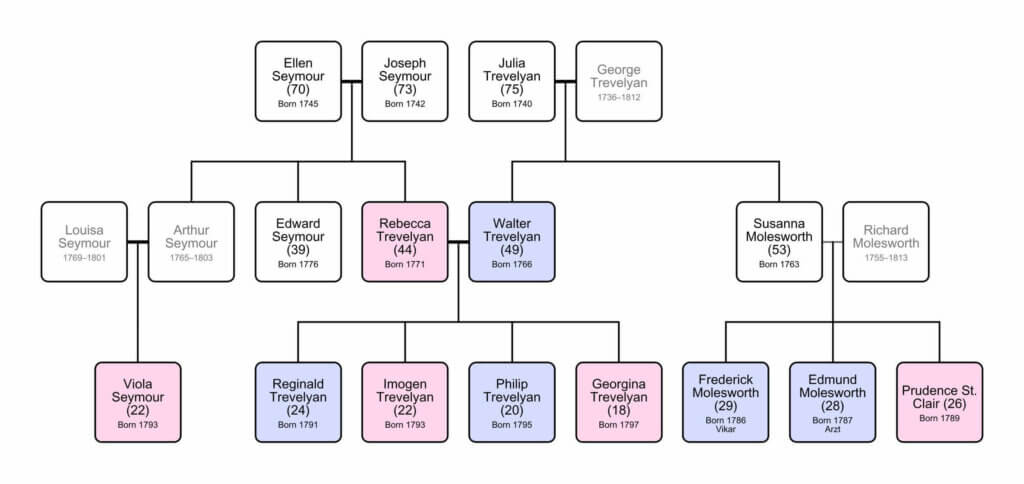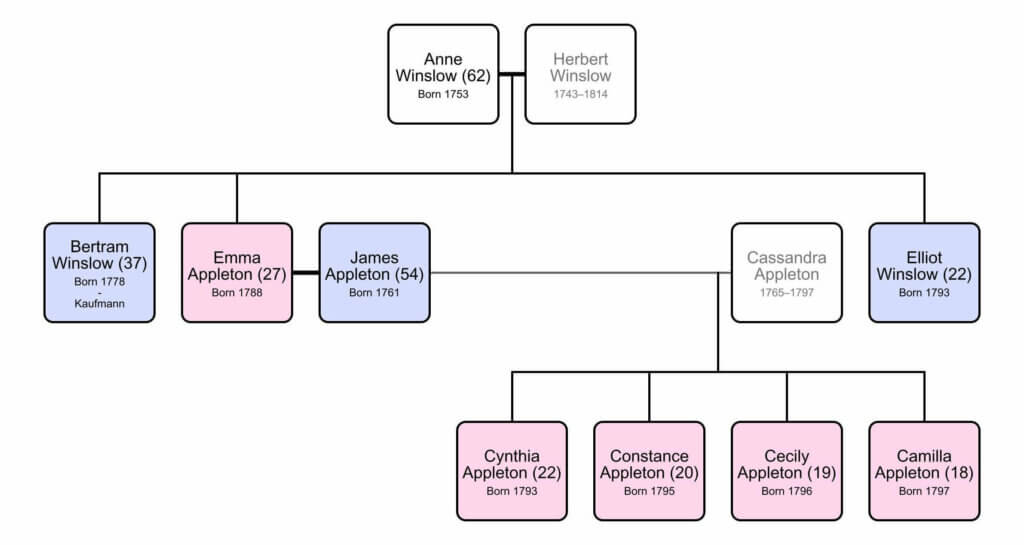
The Pitt Family
Boconnoc House in southeast Cornwall is the ancestral home of the prestigious Pitt family – a political dynasty that has produced two prime ministers in the last 50 years, but has not been spared the odd scandal. Theoretically, the family is headed by George Pitt, the young Baron Camelford, but everyone knows that it is actually his mother Augusta Pitt, The Dowager Lady Camelford, who calls the shots. The family also comprises George’s twin brother Cpt. Henry Pitt and his sister Miss Joanna Pitt. They are accompanied by Lady Caroline Harcourt, Lady Camelford’s younger sister, her nephew The Rev. Barnaby Evelyn, and his sister Miss Beatrice Evelyn. The family has invited Henry’s dear friend Baptist Noel, Earl of Gainsborough, as a guest of honor.
The family’s immense wealth stems from the acquisition and sale of the largest diamond of its time. Lord Camelford’s great-grandfather Robert Pitt had smuggled the diamond in his shoe from India to Europe in 1702 where it was eventually sold to the Regent of France and now forms part of the French crown jewels. The title Lord Camelford, Baron of Boconnoc, was created in 1784 for Lord Camelford’s father, Thomas Pitt, who had previously represented Old Sarum and Okehampton in Parliament. At his death, the title initially passed to his son of the same name, Thomas, from his first marriage. Thomas was a scandal-ridden young man known for his eccentricities and numerous public altercations. He was killed in a duel in 1804, leaving George to succeed him at the tender age of 11.
The Lear Family
The Lear family consists of Sir Peter Lear, Mrs. Margaret Lear, and their nine children, but only the oldest six – Jasper (Sir Peter’s son from his first marriage), Roger, Sophia, Ophelia, Christopher, and Phoebe – are present, while the three younger ones have not yet been introduced into society. They are accompanied by Mrs. Lear’s nephew, Maj. Andrew Turnbull.
The family originally descended from a yeoman from Ipplepen in Devon who had made spectacular progress in his life: he went to Barbados where he worked first as a servant, then as a clerk, and later as a prize commissioner before eventually rising to become one of the island’s most prominent plantation owners. In 1663, his remarkable accumulation of wealth was recognized by King Charles II with the Lear Baronetcy “of London.” However, since this would eventually become extinct at his death due to his lack of children, apparently as a special favor from the crown, he was granted a second baronetcy, “of Lindridge,” shortly before his death in 1683, which could eventually be inherited by his nephews.
These days, however, children are all the Lears have an abundancy of. Sir Peter, in his youth, had agreed to breaking he entail, thus enabling his father to dispose of parts of the family fortune in order to provide his four sisters with adequate dowries. While they are still very grateful to him, Mrs. Lear has been resenting him for his decision for years. Of course, the baronet’s exact financial circumstances were transparent when the marriage contract was concluded, but at that time neither of them could have guessed how many children this union would produce who in turn would have to be provided with an inheritance or a dowry.

The Trevelyan Family
Like the Lears, the Trevelyan family (“Trevilian”) also belongs to the gentry and consists of Mr. Walter Trevelyan, Mrs. Rebecca Trevelyan, and their four children Reginald, Imogen, Philip, and Georgina. Accompanying the family are Mr. Trevelyan’s nephews Frederick Molesworth, vicar of Wadebridge, Edmund Molesworth, a physician, his widowed niece Prudence St. Clair, and Mrs. Trevelyan’s orphaned niece Viola Seymour.
The family derives its surname from a manor in the parish of St. Veep, Cornwall, located in the ancient hundred of West Wivel and was mentioned as early as in the Domesday Book of 1086. Although no one in the family holds a title, it is one of the oldest families in Cornwall, nay, in England – a fact that some of its members never tire of emphasizing. A considerable part of their fortune can be traced back to slave plantations in Grenada.

The Appleton Family
The Appleton family consists of Mr. James Appleton, his second wife Mrs. Emma Appleton, and his daughters from his first marriage, Cynthia, Constance, Cecily and Camilla. They are accompanied by Mrs. Appleton’s brothers, Bertram and Elliot Winslow.
The Appletons moved to Cornwall only two years ago where Mr. Appleton purchased a country estate and married Mrs. Appleton. Originally, his family comes from the north of England where they made their fortune in Liverpool. The Winslows continue to be involved in commerce, though young Elliot pursues a theological degree at Cambridge.
- Alle
- Pitt
- Lear
- Trevelyan
- Appleton
- Ladies
- Gentlemen

George Pitt, The Baron Camelford (25)
Lord Camelford inherited the title of Baron Camelford from his older half-brother Thomas Pitt when he was 11. He is musically gifted, but finds little time to indulge his real passions because of his many duties as a lord.
Highly talented, considerate, critical, overwhelmed

Henry Pitt (25)
Cpt. Pitt is Lord Camelford’s younger twin brother. He gave up his pursuit of a law degree for a career in the cavalry and is now a captain in the 7th Hussar Regiment, also known as “The Saucy Seventh.”
Loyal, amiable, insecure, fellow traveler
⚠ Played by organizer

Joanna Pitt (22)
Miss Pitt is notorious for her eloquence and intellect, which is second to none. Because her privileged family background allows her to have strong opinions of her own, she is always up for a debate.
Sharp-witted, outgoing, spunky, competitive

Augusta Pitt (45)
Dowager Lady Camelford is an energetic woman who is tirelessly committed to the success of her family in order to clear the family name of the scandals of her deceased stepson. She tends to give advice in the form of constructive insults.
Proud, determined, direct, protective

Caroline Harcourt (35)
Lady Caroline is the younger sister of Lady Camelford and aunt of Lord Camelford. Despite her age, she is unmarried and no longer seems to be looking for a husband, since she has made profitable investments with her inheritance.
Strong character, self-confident, informal, sharp-tongued

Harriet Honeyfield (35)
Miss Honeyfield is Lady Caroline’s long-time companion. Her father, a colonel, left her only a small dowry, with which no suitable suitor could be attracted, so that she was forced to take up a respectable occupation. She is now an integral part of the Pitt family.
Helpful, undaunted, talkative, dramatic

Barnaby Evelyn (31)
Mr. Evelyn is the son of Lady Camelford’s older sister Elizabeth. The priest is an enthusiastic, if somewhat quirky, contemporary. His passion for the Lord’s work is matched only by his love for his own voice.
Enthusiastic, carefree, quirky, overconfident

Beatrice Evelyn (24)
Miss Evelyn is the daughter of Lady Camelford’s older sister Elizabeth. She is a hopeless romantic and an admirably innocent and trusting girl; however, her gullibility and naivete do not always serve her well.
Romantic, unprejudiced, fickle, silly

Baptist Noel, The Earl of Gainsborough (30)
Lord Gainsborough is an honored guest of the Pitt family and a good friend of Henry. He has an engaging personality. A true dandy, he always makes a point of being dressed in the latest style and is disdainful of ambitious careerists and hard work.
Quick-witted, sociable, jovial, flighty

Sir Peter Lear (63)
Sir Peter is a dedicated and doting father. Protective and caring, he tends to put all his children’s potential suitors through their paces, being overly demanding – much to his wife’s chagrin.
Fatherly, protective, fastidious, absent-minded

Margaret Lear (42)
In contrast to her husband, Lady Lear tries to find matches for her flock of children in earnest and has her hands full in doing so. She is known among the bachelors of the ton as one of the most tireless mammas.
Busy, resolute, patronizing, old-fashioned

Jasper Lear (24)
Mr. Jasper Lear is Sir Peter’s son from his first marriage. Unlike his eight half-siblings, he has comparatively little to worry about in terms of his financial future, as he will inherit not only titles but also the lion’s share of his father’s (few) estates.
Rascal, nonchalant, conceited, devious

Roger Lear (22)
Lt. Lear is the eldest son of Sir Peter and Lady Lear and his mother’s favourite. As a naval officer, he was aboard the ship, HMS Bellero-phon, by which Napoleon was captured a few weeks ago.
Patient, steadfast, sentimental, uptight

Sophia Lear (21)
Miss Lear is the eldest daughter of Sir Peter and Lady Lear and was trained by her mother to be an accomplished young lady and thus a role model for her sisters. She cares deeply for those around her and is easily impressed by others.
Conscientious, interested, caring, impressionable

Ophelia Lear (20)
Miss Ophelia is a typical middle child who is often called upon to mediate in family disputes. Without being prompted, she also likes to offer her help, mainly to satisfy her own curiosity about the affairs of others.
Diplomatic, pragmatic, curious, family-oriented
⚠ Played by organizer

Christopher Lear (19)
Mr. Christopher Lear is friendly, extremely talkative, and inclined toward the simple pleasures of life. Instead of focusing on his studies at Cambridge to later take up employment like Roger, he spends most of his time with his fellow students in pubs and clubs.
Carefree, talkative, pleasure-seeking, dawdling

Phoebe Lear (18)
Miss Phoebe is the youngest of the Lear children present and by far the most temperamental of them all: always up for mischief, easily offended, but also quick to forgive. She doesn’t like to be told what to do and has proven to be a particular headache for her mother.
Mischievous, bubbly, snarky, cheeky

Andrew Turnbull (34)
Maj. Turnbull is the younger son of Lady Lear’s older sister Marianne. Like the other officers, he has just returned from the battlefield and never misses an opportunity to tell of his exploits.
Straightforward, energetic, cocky, reckless

Walter Trevelyan (49)
Mr. Trevelyan is outwardly stern, dour, and eager to lead by example. He is very proud of his family’s long history, which can be traced back to the time of William the Conqueror.
Dignified, traditional, moody, risk averse

Rebecca Trevelyan (44)
Mrs. Trevelyan is known for her disarming friendliness. She moves confidently and naturally in the social arena and will use her skills to arrange appropriate matches for her children.
Charming, assertive, superficial, calculating

Reginald Trevelyan (24)
Mr. Reginald Trevelyan is the eldest son of Mr. and Mrs. Trevelyan. He is completely absorbed in his role as heir and takes it very seriously – much to the chagrin of his siblings – so that he tends to patronize his younger siblings.
Duty-conscious, down-to-earth, stuffy, sententious

Imogen Trevelyan (22)
Miss Trevelyan is the eldest daughter of Mr. and Mrs. Trevelyan and, as an accomplished young lady, the pride of her entire family. Her only flaw is that she is somewhat prone to daydreaming and, in her generosity, allows others more second chances than they potentially deserve.
Sensitive, dreamy, trusting, unable to make decisions

Philip Trevelyan (20)
Mr. Philip Trevelyan is a all-round affable fellow, by no means lacking in wit, but very much in seriousness. One might think that he considers it his duty to entertain his siblings.
Friendly, humorous, naive, awkward

Georgina Trevelyan (18)
Miss Georgina can usually be found outdoors or running away from her governess. Shy in public, she knows much more about her family’s affairs than she appears to.
In touch with nature, shy, affectionate, emotional

Frederick Molesworth (29)
Mr. Frederick Molesworth is the eldest son of Mr. Trevelyan’s older sister. With his suave and winning manner, the ambitious priest is able to effortlessly hide the fact that he is only the son of a merchant.
Charismatic, ambitious, idealistic, stubborn

Edmund Molesworth (28)
Mr. Edmund Molesworth is the younger son of Mr. Trevelyan’s older sister. Since a university education had to be financed for his brother and a dowry for his sister, he was left to train as a doctor, which at least made him a valuable member of the community.
Sincere, incompetent, gullible, lost in thought

Prudence St. Clair (26)
Mrs. St. Clair is the younger sister of the Molesworth brothers. She was widowed a year ago after her husband was killed in the wars on the Iberian Peninsula. She seems to be enjoying her newfound freedom now that the mourning period is over, and is more interested in science than in renewed marriage.
Intelligent, freedom-loving, renitent, skeptical

Viola Seymour (22)
Miss Seymour is the orphaned niece of Mrs. Trevelyan, taken in by her aunt’s family after the death of her father when she was ten. She is like another sister to her cousins, even though her quick-tempered nature is sometimes considered a bad an influence in the eyes of her aunt.
Passionate, strong-willed, reliable, suspicious

James Appleton (54)
Mr. Appleton comes from a family of merchants who, in his generation, have now financially reached the point of venturing into the more genteel classes. He knows that, while he may not necessarily measure up in terms of style and etiquette, he has money on his side.
Laid-back, outgoing, unpolished, blunt

Emma Appleton (27)
Mrs. Appleton is the daughter of a merchant from Plymouth. Although her father had put a lot of money into her education, she had failed to marry a distinguished heir despite her many accomplishments, so her mother urged her to marry Mr. Appleton.
Graceful, reflective, ambitious, self-righteous

Cynthia Appleton (22)
Miss Appleton is the eldest daughter of Mr. Appleton’s first marriage. She makes no secret of the fact that she is highly eager to make the best possible match in order to move up the social ladder.
Sensual, determined, resentful, opportunistic

Constance Appleton (20)
Ms. Constance is a highly peculiar young woman who, much to the displeasure of her parents, likes to play around with exclusively male customs and has very headstrong visions of her future, which primarily do not include marriage.
Clever, whimsical, fearless, unconventional

Cecily Appleton (19)
Miss Cecily likes nothing better than to flirt with the gentlemen and spends time with one or the other without being under the watchful eye of a chaperone. It is unclear whether she is looking for a husband or averse to marriage.
Coquettish, playful, headstrong, haughty

Camilla Appleton (18)
Miss Camilla is the youngest of the Appleton daughters. She feels most at home at balls and parties and captivates with her carefree cheerfulness, which at first glance can mask any hint of impudence.
Fun-loving, carefree, selfish, petulant

Bertram Winslow (37)
Mr. Bertram Winslow is Mrs. Appleton’s older brother. He has taken over her father’s business and, along with his brother-in-law Mr. Appleton, seeks to join good society.
Eloquent, persistent, yearning, calculating

Elliot Winslow (20)
Mr. Elliot Winslow is Mrs. Appleton’s younger brother. In addition to his sister, the hopes of social advancement also rest on him, so that his studies in theology are financed by his older brother Bertram.
Creative, winning, decisive, restless





